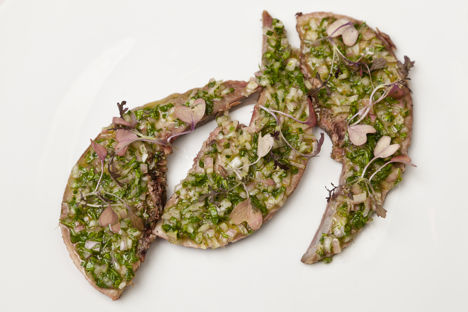Though it might make your skin crawl to look at, tongue is a muscle and actually tastes more like regular meat than offal, without that distinctive ‘offal’ flavour like liver or kidneys do. The tongue is eaten from many animals across the world, most commonly ox, calf, lamb and pig – even tiny duck tongues are fried up as a delicacy in China.
If you can get over the look of tongue, you’re halfway there. The preparation is minimal but it does take a good few hours to cook. The result, however, is delicious, with the cooked muscle often cubed or finely sliced (rather than being served whole on the plate, which would be a challenge for even the most adventurous gourmand!).
While you won’t find tongue for sale in the supermarkets, good local butchers will have them, and if not, they should be able to get hold of them for you if you ask. The flesh should be firm and without any cuts. Most tongues will have a greyish tinge and dark spots on the tongue are common; this is fine and you shouldn't worry, as the skin is removed before eating anyway.
Depending on your recipe, you might want to want to brine the tongue before cooking. Some butchers sell salted tongues, or you can brine them yourself at home, which allows you to flavour the meat to your liking. Tongue is usually slow-cooked in liquid to break down the tough muscles, then pressed and thinly sliced, or diced and fried until crisp. Below is a basic recipe for preparing tongue at home.
Metric
Imperial
- 1 lamb's tongue, ox tongue, pig tongue or veal tongue
- 1 onion, peeled and quartered
- 1 carrot, washed and roughly chopped
- 3 garlic cloves, bashed
- 1 bunch of thyme
- 1 tsp black peppercorns
- butter, for frying
- salt, to taste
Tongue is a very rich, fatty cut so is paired well with sharp flavours. Pascal Aussignac dresses slices of pig tongue with a zingy caper and mustard ravigote sauce. The beefy taste of ox tongue also matches well with traditional beef condiments such as horseradish or mustard; Ollie Moore pairs it with earthy celeriac and umami-packed Marmite bread.
Serve up lamb tongue slices with a mint salsa verde, or like the rest of the animal, lamb tongues stand up well to a bit of spice; think Persian or Moroccan flavours.
If you’re keen to try out tongue but still a little squeamish about the idea, try Christina Bowerman’s Tongue pastrami recipe. Cured, sliced and put into a deli-style sandwich with sharp Italian pickles, it tastes like an extra beefy ham. You wouldn’t know it was offal at all!
Another popular tongue dish is the Mexican tacos de lengua (tongue tacos); dice and marinate the cooked tongue in orange and lime juice, cumin and chilli, then crisp up in a hot pan and serve up with corn tortillas, shredded red cabbage, pink pickled onions, jalapeños and plenty of fresh coriander.
Get in touch
Please sign in or register to send a comment to Great British Chefs.


